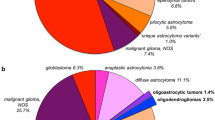Abstract
Pediatric oligodendrogliomas are rare neoplasms and have not been characterized extensively either pathologically or genetically. Given the recent interest in the significance of chromosomal losses in predicting the clinical course and in establishing uniform diagnoses of adult oligodendrogliomas, we reviewed the pathological and clinical features of a series of pediatric oligodendrogliomas and determined their 1p and 19q status using fluorescence in situ hybridization. Of 19 tumors originally diagnosed as oligodendroglioma, 7 were oligodendroglioma, 3 were anaplastic oligodendroglioma, 3 were oligoastrocytoma, and 6 were reclassified. Only one tumor, an anaplastic oligodendroglioma, had 1p loss; none had 19q loss. The single patient whose tumor had 1p loss did not have a particularly favorable clinical course. These results suggest that pediatric oligodendrogliomas arise by molecular alterations distinct from adult oligodendrogliomas, and such molecular alterations do not hold immediate promise as an adjunct to the diagnosis of pediatric oligodendrogliomas.




Similar content being viewed by others
References
Bauman GS, Ino Y, Ueki K, Zlatescu MC, Fisher BJ, Macdonald DR, Stitt L, Louis DN, Cairncross JG (2000) Allelic loss of chromosome 1p and radiotherapy plus chemotherapy in patients with oligodendrogliomas. Int J Radiat Oncol Biol Phys 48:825–830
Burger PC, Minn AY, Smith JS, Borell TJ, Jedlicka AE, Huntley BK, Goldthwaite PT, Jenkins RB, Feuerstein BG (2001) Losses of chromosomal arms 1p and 19q in the diagnosis of oligodendroglioma. A study of paraffin-embedded sections. Mod Pathol 14:842–853
Cairncross JG, Ueki K, Zlatescu MC, Lisle DK, Finkelstein DM, Hammond RR, Silver JS, Stark PC, Macdonald DR, Ino Y, Ramsay DA, Louis DN (1998) Specific genetic predictors of chemotherapeutic response and survival in patients with anaplastic oligodendrogliomas. J Natl Cancer Inst 90:1473–1479
Da C, Celestino JC, Okada Y, Louis DN, Fuller GN, Holland EC (2001) PDGF autocrine stimulation dedifferentiates cultured astrocytes and induces oligodendrogliomas and oligoastrocytomas from neural progenitors and astrocytes in vivo. Genes Dev 15:1913–1925
Dohrmann GJ, Farwell JR, Flannery JT (1978) Oligodendrogliomas in children. Surg Neurol 10:21–25
Ino Y, Betensky RA, Zlatescu MC, Sasaki H, Macdonald DR, Stemmer-Rachamimov AO, Ramsay DA, Cairncross JG, Louis DN (2001) Molecular subtypes of anaplastic oligodendroglioma: implications for patient management at diagnosis. Clin Cancer Res 7:839–845
Kendler A, Golden JA (1996) Progenitor cell proliferation outside the ventricular and subventricular zones during human brain development. J Neuropathol Exp Neurol 55:1253–1258
Okada Y, Nishikawa R, Matsutani M, Louis DN (2002) Hypomethylated X chromosome gain and rare isochromosome 12p in diverse intracranial germ cell tumors. J Neuropathol Exp Neurol 61:531–538
Packer RJ, Sutton LN, Rorke LB, Zimmerman RA, Littman P, Bruce DA, Schut L (1985) Oligodendroglioma of the posterior fossa in childhood. Cancer 56:195–199
Pollack IF, Hamilton RL, Finkelstein SD, Campbell JW, Martinez AJ, Sherwin RN, Bozik ME, Gollin SM (1997) The relationship between TP53 mutations and overexpression of p53 and prognosis in malignant gliomas of childhood. Cancer Res 57:304–309
Pollack IF, Finkelstein SD, Burnham J, Hamilton RL, Yates AJ, Holmes EJ, Boyett JM, Finlay JL (2003) Association between chromosome 1p and 19q loss and outcome in pediatric malignant gliomas: results from the CCG-945 cohort. Pediatr Neurosurg 39:114–121
Raghavan R, Balani J, Perry A, Margraf L, Vono MB, Cai DX, Wyatt RE, Rushing EJ, Bowers DC, Hynan LS, White CL 3rd (2003) Pediatric oligodendrogliomas: a study of molecular alterations on 1p and 19q using fluorescence in situ hybridization. J Neuropathol Exp Neurol 62:530–537
Razack N, Baumgartner J, Bruner J (1998) Pediatric oligodendrogliomas. Pediatr Neurosurg 28:121–129
Sasaki H, Zlatescu MC, Betensky RA, Johnk LB, Cutone AN, Cairncross JG, Louis DN (2002) Histopathological-molecular genetic correlations in referral pathologist-diagnosed low-grade “oligodendroglioma”. J Neuropathol Exp Neurol 61:58–63
Smith JS, Perry A, Borell TJ, Lee HK, O’Fallon J, Hosek SM, Kimmel D, Yates A, Burger PC, Scheithauer BW, Jenkins RB (2000) Alterations of chromosome arms 1p and 19q as predictors of survival in oligodendrogliomas, astrocytomas, and mixed oligoastrocytomas. J Clin Oncol 18:636–645
Acknowledgments
Supported in part by NIH CA57683. We would like to thank Ravi Raghavan for kindly sharing their unpublished data prior to submitting their manuscript.
Author information
Authors and Affiliations
Corresponding author
Rights and permissions
About this article
Cite this article
Kreiger, P.A., Okada, Y., Simon, S. et al. Losses of chromosomes 1p and 19q are rare in pediatric oligodendrogliomas. Acta Neuropathol 109, 387–392 (2005). https://doi.org/10.1007/s00401-004-0976-2
Received:
Revised:
Accepted:
Published:
Issue Date:
DOI: https://doi.org/10.1007/s00401-004-0976-2




